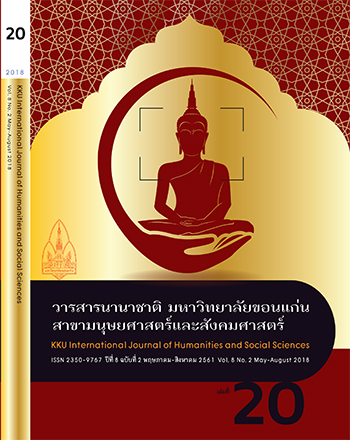Characteristics of Novels Translated from Chinese by Her Royal Highness Princess Maha Chakri Sirindhon
Main Article Content
Abstract
This article aims to study the art of literature and the content of novels by Royal Highness Princess Maha Chakri Sirindhon, which include “Peeseua” “Makhernnamlai”, “Moo banlekdragoonpao”
“Nareenakara” and “Dalorgannanankaenai” that depict the change of China's politics and society under communism until periods under capitalism and cosumerism, and also shows conflicts between cultural adjustment and cultural interaction.
The study showed that these novels by Her Royal Highness Princess Maha Chakri Sirindhon portrayed notable characteristics in terms of the content of the art and literature follows. There were two distinguished characteristics for the art of literature were word selection and the use of figures of speech. The art of word selection includes the customization of compound words, word sets and antonyms, while the use of figures of speech, similes, metaphors and onomatopoeia were also involved in her works. The study compared the translated from Chinese novels of Her Royal Highness Princess Maha Chakri Sirindhon with original Chinese novels and showed that the context was written remarkably under three aspects of point of view, characters and scenes. Point of views in these novel portrayed the idea of the clash between conservative values and modern values, goodness is enduring sustainability, the coexistence of diverse individuals and family love. These ideas show that change is impermanent, while goodness and love are permanent and constant. In the aspect of character female characters are more outstanding than male characters as they are brave and capable of doing the same duties as men do. For the selection of illustrious scenes nature scenes and community scenes which embody values of traditional culture, preservation of cultural heritage and opening up to modern culture as well. The translated from Chinese novels of Her Royal Highness Princess Maha Chakri Sirindhon were written gracefully with splendid word selection and refined language enabling readers to perceive the feelings of characters and imagined how Chinese culture and society were familiar with Thai society.
In connection with the above aspects above, the translated from Chinese novels were highly to advantageous for Thai society and Thai people. The Readers could realize the values of goodness and love which make humans happy and allow them to live peacefully together in a community. In addition, the nature scenes illustrated and emphasized the feelings of the characters to be more prominent.
Article Details
References
ญาดา อรุณเวช อารัมภีร์. (2558). รัตนศิลปิน. พิมพ์ครั้งที่ 1. กรุงเทพฯ: บัวสรวง.
ทีมข่าวสตรี. (2560, 24 มีนาคม). เจ้าฟ้านักประพันธ์แห่งกรุงรัตนโกสินทร์ สมเด็จพระเทพรัตนราชสุดาฯ สยามบรมราชกุมารี. ไทยรัฐ. หน้า 21.
เถี่ยหนิง. (2557). ตลอดกาลน่ะนานแค่ไหน. แปลโดย เทพรัตนราชสุดาฯ สยามบรมราชกุมารี, สมเด็จพระ. พิมพ์ครั้งที่ 2. กรุงเทพฯ: นานมีบุ๊คส์.
ฟังฟัง. (2555). เมฆเหินน้ำไหล. แปลโดย เทพรัตนราชสุดาฯ สยามบรมราชกุมารี, สมเด็จพระ. พิมพ์ครั้งที่ 18. กรุงเทพฯ: นามีบุ๊คส์.
มาตยา อิงคนารถ. (2542). ประวัติศาสตร์จีนสมัยใหม่. พิมพ์ครั้งที่ 3. กรุงเทพฯ: มหาวิทยาลัยรามคำแหง.
รื่นฤทัย สัจจพันธุ์. (2559, พฤษภาคม - มิถุนายน). พระราชนิพนธ์แปลวรรณกรรมจีนร่วมสมัยในสมเด็จพระเทพรัตนราชสุดาฯ สยามบรมราชกุมารี. วารสารมนุษยศาสตร์และสังคมศาสตร์. 8(2): 1-33.
รื่นฤทัย สัจจพันธุ์ (2556). มิใช่เพียง “นางเอก”. กรุงเทพฯ: สถาพรบุ๊คส์.
วาณี พนมยงค์ สายประดิษฐ์. (2552). ภาคผนวก. ใน ผีเสื้อ. หน้า 210-236. กรุงเทพฯ: นานมีบุ๊คส์.
สิทธา พินิจภูวดล . (2541, มกราคม). เรืองประกายลายอักษร ในพระราชนิพนธ์แปล สมเด็จพระเทพรัตนราชสุดาฯ สยามบรมราชกุมารี. วัฒนธรรมไทย. 35(4): 32-34.
หวังอันอี้. (2555). หมู่บ้านเล็กตระกูลเป้า. แปลโดย เทพรัตนราชสุดาฯ สยามบรมราชกุมารี, สมเด็จพระ. พิมพ์ครั้งที่ 1. กรุงเทพฯ: นานมีบุ๊คส์.
หวางเหมิง. (2552). ผีเสื้อ. แปลโดย เทพรัตนราชสุดาฯ สยามบรมราชกุมารี, สมเด็จพระ. พิมพ์ครั้งที่ 13. กรุงเทพฯ: นานมีบุ๊คส์.
池莉. (2001). 她的城. 第1版. 南京: 江方文艺.
方方. (1992). 行云流水. 第1版. 长江文艺.
铁凝. (2006). 永远有多远. 第1版. 北京: 人民文学.
王安忆. (2009). 小鲍庄. 第1版. 广州: 花城.
王蒙. (2007). 蝴蝶 之 蝴蝶为什么美丽: 王蒙五十创作精读. 第1版. 上海: 夏旦大学.

